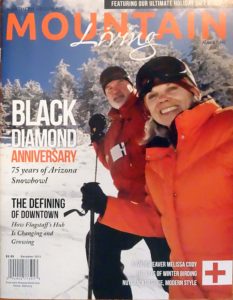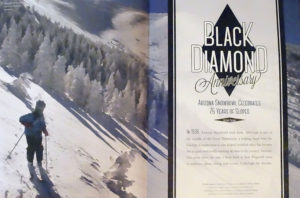![]() December 2013
December 2013
 In 1938, Arizona Snowbowl took form. Although it was in the middle of the Great Depression, a helping hand from the Civilian Conservation Corps helped establish what has become the longest continually running ski area in the country. Seventy-five years later, we take a look back at Flagstaff came to embrace alpine skiing and sustain it through the decades.
In 1938, Arizona Snowbowl took form. Although it was in the middle of the Great Depression, a helping hand from the Civilian Conservation Corps helped establish what has become the longest continually running ski area in the country. Seventy-five years later, we take a look back at Flagstaff came to embrace alpine skiing and sustain it through the decades.
As snowbound travelers heading north descend into Camp Verde, they get their first peak at the San Francisco Peaks. Arizona Snowbowl sits like a beacon, welcoming anyone who gets their thrills from whizzing across icy, white stuff with boards strapped to their feet. Teens dream of getting the latest equipment for Christmas and locals plan out how to make the most of their season ski pass. In winter, all eyes are on the snow report.
It wasn’t always that way. Norwegian brothers, Ole and Pete Solberg, introduced the wild notion of skiing. They had grown up on skis before emigrating to Flagstaff. So when a record winter delivered abundant snow in January 1915, Ole and Pete carried their homemade equipment up Observatory Hill and skied down. The next day, the entire town turned out to watch the men. Despite Ole catching a ski on an exposed row of barbed wire fence and being thrown against a rock, historian Jane Jackson said, “Skiing made its debut.” And it caught on.
Cross country skiing was the norm for years for utilitarian reasons. Road weren’t paved, except for downtown. Ice skating on local reservoirs became popular and sloping Leroux Street was blocked off for sledding. Children also hung onto bumpers and street coasted behind cars.
The 1930s were a turning point for snow sports. Arizona State Teachers College, now Northern Arizona University, advertised snowmen and skiing to lure students and held the first winter carnival in 1933. The 20-30 Club—a national service organization—also promoted skiing. They sponsored a sports day with 50-cent rentals to “try out the new fad.”
Some boys found skis from J.C. Penney’s catalog under the Christmas tree. Jimmie Nunn, who decades later founded Arizona Ski Museum, said, “I’d tie the skis to my bike and ride the five miles out to Sheep Hill (by present-day Flagstaff Mall). My friends and I would walk up and ski down. We’d be pretty tired and hope someone would give us a lift back.” Families also used Hochderfer Hill, a cinder cone on Hart Prairie, when Fort Valley Road was accessible. Snow sports gained momentum, but only near town.
To the Mountain
 In 1935, someone finally looked at the San Francisco Peaks that fixate us today and put skiing and the mountain together. Forester Ed Groesbeck arrived in Flagstaff as the Timber Staff Officer, responsible for timber sales, land usage and exchange—as well as recreation. He saw the skiing possibilities, but, with the Depression, money was tight. Fortunately, the Civilian Conservation Corp was ready and willing.
In 1935, someone finally looked at the San Francisco Peaks that fixate us today and put skiing and the mountain together. Forester Ed Groesbeck arrived in Flagstaff as the Timber Staff Officer, responsible for timber sales, land usage and exchange—as well as recreation. He saw the skiing possibilities, but, with the Depression, money was tight. Fortunately, the Civilian Conservation Corp was ready and willing.
The New Deal agency was rife with young men who learned trades while working in forests and parks around the country. And Groesbeck had plenty for them to do. The CCC constructed nearly 6,000 miles of trails and minor roads in Arizona, hung telephone lines and planted seedlings. As Jackson said, “The CCC was easily the most unlikely group of ski pioneers.” The CCC’s first task was cutting six miles of road up to Agassiz, and later, they finished the job. The CCC also constructed a 95- by 25-foot lodge with three fireplaces, glass observation deck, plus repair and storage facilities in 1940.
The first event on the mountain took place 75 years ago in 1938, likely at Aspen Corner, known then as Scissorbill Park. A scissorbill was a novice, nuisance skier, as most locals were. The next season premiered the Ice and Snow Fiesta with increased activities and races. The huge success encouraged a contest to name the resort, and Arizona Snowbowl won.
Ski teams gained firm footing at the college, Flagstaff High School, Prescott’s PreSKImos and Flagstaff Ski Club. Nunn and Dr. Wayne Frerichs became friends in the early 1940s, even as they skied against one another. Frerichs from Prescott remembered the men’s winter jaunts to Snowbowl. “We’d stay overnight in sleeping bags in the lodge, or at a discount at the Monte Vista,” he said. “We all wanted a Norwegian sweater with a reindeer on it, if we could get it.” Both men fondly relived the heated competition for the Midgley Cup, donated by Maj. W.W. and Gerry T. Midgley, for a cross country win. Frerichs and Nunn still ski together.
After the War
Snowbowl was only closed for one season during WWII and offered discounts for servicemen. After the war, Flagstaff Ski Club, the volunteer group which ran Snowbowl, put it up for sale. Al and Venn Grasmoen were driving cross-country and stopped in. With help from his banker brother, Al Grasmoen bought the facilities and acquired the lease from the Forest Service. He was a hard-driving man with a vision. As Jackson put it, “The father of Arizona Snowbowl was Ed Groesbeck, but Al Grasmoen has the vision for turning Snowbowl into the resort it is today.”
Grasmoen bought rental skis in an army auction and started cutting trails. The best was 20-feet wide, but others were just trails. Jackson said, “If the trail was wider than your hands outspread, it was too wide.”
Rope tows were added. Bill Williams said, “We had one 3,000-footer, which had the reputation of being the longest rope tow in the West.” He and others recalled the frustration of maintenance and wet gloves slipping on the rope. Grasmoen acquired a Pomalift, with a disc on a rope to lean on, which Williams said, “Was like heaven.” The mountain became a family of folks who worked cutting trails, clearing land or building each summer and skied together each winter. Teens would ride the lift up and snow step down to groom the runs. Twice down earned a free lift ticket.
National Ski Patrol organized, and Nunn trained and joined up in high school. Williams also loved the all-volunteer job working weekends and holidays. The men tied poles and skis together for a litter or used a rigged toboggan. Back then, injuries were generally a turned ankle.
The CCC lodge burned down in 1952, and the mountain family mourned the loss. Undeterred, Grasmoen began work on a new lodge further up Agassiz Peak. Everyone pitched in skinning logs, hauling blocks, mudding and more, and Agassiz Lodge rose rapidly over a couple of seasons. Nunn, a Phoenix architect then, said, “Al sketched some plans on a pad, and then, started building. The lodge was half-built before the Forest Service said, ‘Where are the plans? What about a permit?’” Nunn took dimensions of the building, made working plans and put his registration seal on it for approval.
Getting a Lift
The enthusiasm surrounding Snowbowl was high. Williams told of Snow Ranger, Jay Shoemaker, who zealously sought to control any avalanche danger. “He got the bright idea to bring in the National Guard with a howitzer and set it out in front of the lodge.” Snowbowl was closed, and they aimed the gun at the hill, which is contentious today, and fired the gun. The concussion blew out half of the windows in the lodge. He continued firing. Williams then had the honors of riding the lift up to have a look and call in the “all clear.” “When I got up there,” Williams said, “Jay had blown the tree with the telephone to smithereens.”
In 1962, five businessmen bought Snowbowl and purchased the first chair lift. Construction of the two-seater Riblet was a volunteer family affair as always. Winters are unreliable, and the resort traded hands a few times because of dry seasons. During a decade of corporate ownership, more upgrades like a three-seater chair, Sunset lift, parking lot upgrades and re-routing roads took place.
In 1992, Eric Borowsky and partners bought Arizona Snowbowl. This group, which has owned the facility longer than any other, widened Logjam, added the Volcano and Lava runs, ski trails, a snowboard park and ski schools, extended the lodge deck, and finally, brought in snowmaking. Though it is controversial and legally contested for its use of treated effluent—leading to environmental and cultural concerns—Arizona Snowbowl operators stood by the project in order to create reliable ski seasons.
Owner of Peace Surplus Steve Chatinsky has seen many weather cycles. “We’ve been like farmers,” he said. “But we have a lot to celebrate after 40 years—snowmaking creates a dependable winter season.” He feels lucky every day to have such a great community in which to live.
Brian Dierker, who has owned Humphrey Ski Summit since 1978, sees the recent upgrades as forward-thinking, too. “People who haven’t been up on the mountain in a while will be pleasantly shocked with the improvements.” This has created more competition in services. Dierker likes nothing more than to be up on the mountain early. “It’s like church. Three or four runs, and I’m off to work.”
Skiing has created a year-round destination from a summertime town. It is part of the fabric of Flagstaff. And that often looks like snowboard pants and goggles. The ski team is now Flagstaff Alpine and Snowboard Team. Every business in Flagstaff benefits from the steady stream of guests in need of services.
For all its efforts to blaze a ski trail, Arizona Snowbowl can claim its place as the longest continually run ski resort in the U.S. Not bad for a small town with a big mountain and a big dream. NAMLM Gail G. Collins
